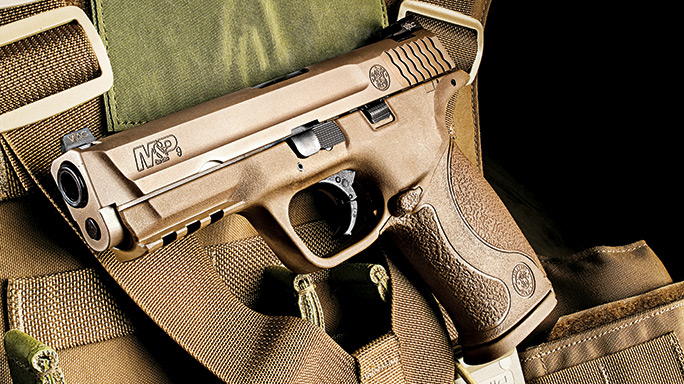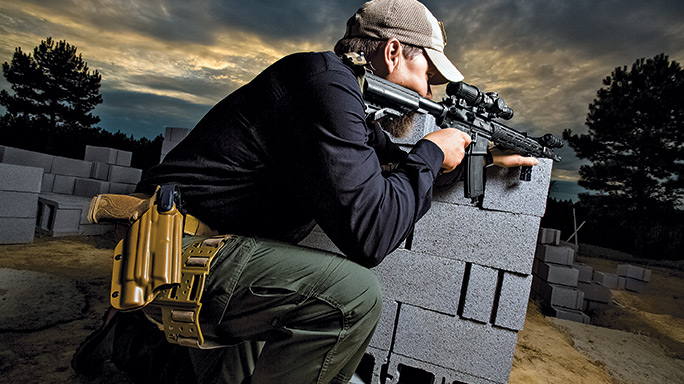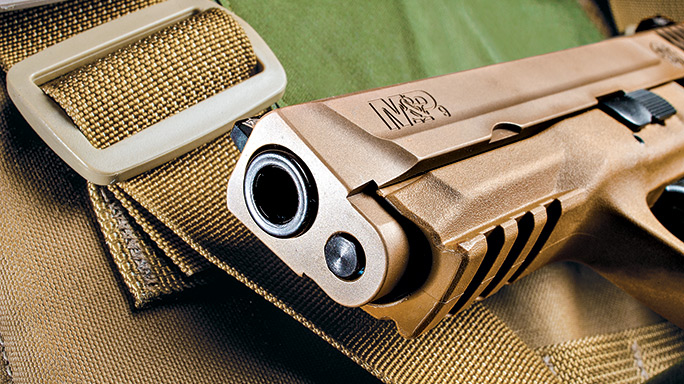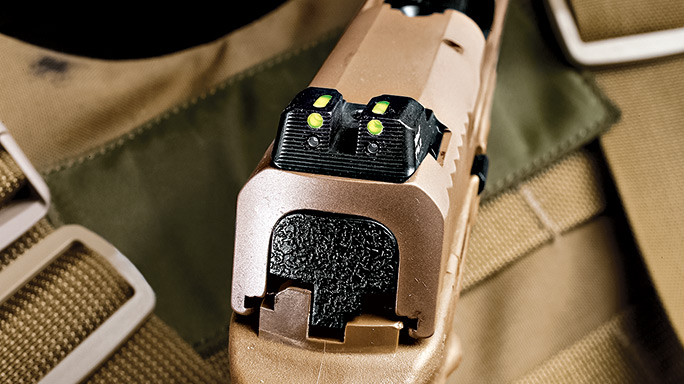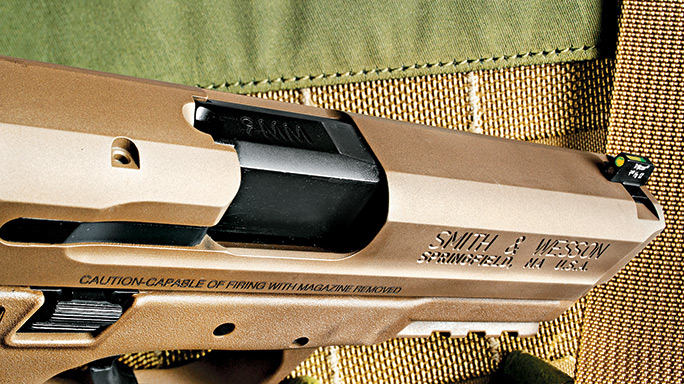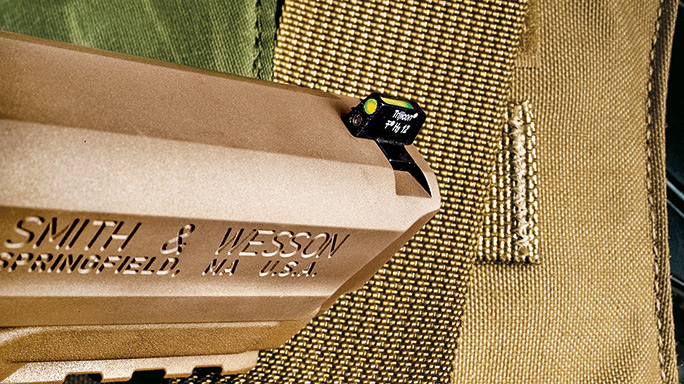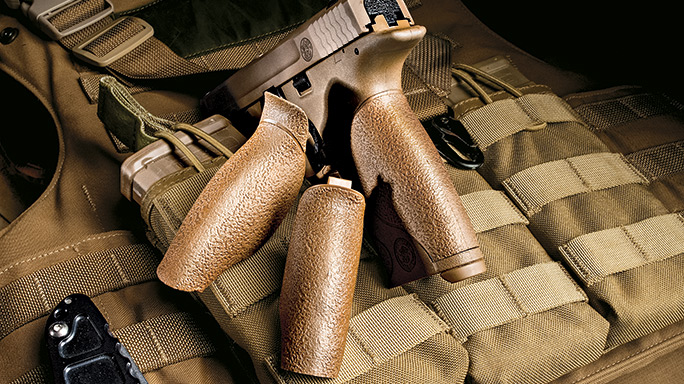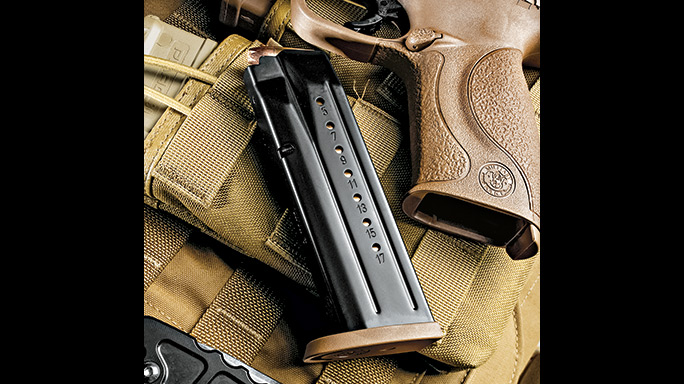The M&P pistol series represents the top of the line for Smith & Wesson’s polymer-framed semi-autos. M&Ps are offered in full-sized, compact and subcompact models and in several chamberings, including .22 LR, 9mm, .40 S&W and .45 ACP.
- RELATED STORY: Massad Ayoob Reviews the Smith & Wesson M&P22 Compact
For those looking for an enhanced version of the design, S&W introduced the M&P9 VTAC, which features modifications from Viking Tactics, a highly respected operation run by former Delta operator Kyle Lamb. It is currently only available as a full-sized pistol in 9mm, and I recently got my hands on a model for testing.
Gun Details
Advertisement — Continue Reading Below
The VTAC is built using the M&P design envelope, which means it is highly durable and equipped with features required by professional users. These include steel sights, a heavy-duty extractor, and a stainless steel barrel, slide and recoil-spring guide rod. To increase its durability, the M&P’s polymer frame is molded around a one-piece stainless steel chassis that incorporates the slide rails and locking block. The action parts are also connected to the chassis. The M&P design parameters contrast others that use plastic sights and guide rods, mold the slide rails and locking block into the frame, and do not have a steel-to-steel connection to each like the M&P’s chassis.
M&P pistols have much to offer, including durability, a very well- designed grip and, with 17+1 rounds of 9mm, one of the most impressive capacities available for full-sized pistols. Though most M&P pistols have a corrosion-resistant finish applied to the barrel, slide and steel sights, the VTAC’s slide is finished in an enhanced Flat Dark Earth PVD and has specialized sights designed by Kyle Lamb. These sights are the main reason why the VTAC is one of the more expensive guns in the M&P line. Viking Tactics is a tactical training company that also sells firearm accessories.
Like all M&P pistols, the VTAC is striker-fired. Striker-fired pistols do offer advantages over designs using exposed hammers. The most important is the ability to bring the bore’s axis as close as possible to the firing hand. Mounting the barrel close to the firing hand directs more of the recoil directly rearward, as opposed to pistols with higher-mounted barrels that cam the muzzle upward during recoil. The striker-fired design is possible because there is no hammer, which would normally require the bore to move higher to accommodate the hammer’s forward arc when it strikes the firing pin.
Advertisement — Continue Reading Below
Field-stripping the VTAC is simple but requires an additional step: pushing the sear downward so that it does not engage the striker. (If you are unfamiliar with the gun, you’re unlikely to understand this step, so please read the manual even if you believe you are knowledgeable about firearms!) After removing the magazine and ensuring the chamber is empty, lock the slide to the rear and look downward into the open action to locate a small metal tab that’s painted yellow. This tab must be pushed downward using the tool contained in the pistol’s grip or another pointed device. Pushing the tab downward presses the sear out of alignment with the rear of the striker. Once done, the takedown lever can be rotated downward and the slide assembly removed forward off the frame. Though the tab is small and seems flimsy, it has no function other than to allow takedown—if it breaks, it won’t render your pistol inoperable in a gunfight.
The VTAC’s unique sights are made by Trijicon and only offered on the M&P9 VTAC. These sights are intended to be rapidly and highly visible in different lighting conditions. They accomplish that by using three green fiber-optic and three green tritium inserts. Both the fiber-optic and tritium inserts are arranged in a three-dot design, with the fiber optics on the top and the tritium inserts directly below. In daylight the fiber-optic dots glow; in low-light conditions, the tritium inserts take precedence. The VTAC’s front sight is tapered, and the notch on the rear sight is quite deep. Also, the rear sight has a squared leading edge known as a cocking ledge, which allows you to keep the gun running if one hand is incapacitated: To chamber a round or clear a malfunction, simply rack the slide by catching the rear sight on a holster, a mag pouch or the heel of your boot.
The M&P9 offers one of the best-designed grips available, and it borrowed from the very large research and development investment Smith & Wesson made on the Sigma’s grip. That pistol was introduced in about 1992. The Sigma’s grip was the best available when it was introduced, and is still considered to be among the best grips now. One of the results of that research and development was that an 18-degree grip angle was ideal for naturally pointing a pistol, and all of the company’s polymer designs use this.
Advertisement — Continue Reading Below
The M&P9’s grip is more versatile than the Sigma’s because it can be adjusted to best fit the shooter’s firing hand using one of three sizes of palm-swell grip panels. These panels are easily changed by simply removing a pin from the base of the frame and then removing the grip panel. Changing the grip panel is not merely changing the backstrap, as with Glock Gen4 pistols. Rather, the M&P9 grip panel changes the backstrap and grip sides. Moreover, S&W got it right with the contour of the grip side panels: They fit the curve of your hand rather than being flat-sided.
Changing the size of the grip panel improves comfort, but the most important advantage of this design is to position your finger on the trigger so that your trigger stroke is straight to the rear and does not disturb the sights. What size is best for you? Dry-fire using each grip panel and focus on the front sight as the striker releases. Select the one that gives you the best trigger control.
Range Time
Advertisement — Continue Reading Below
I tested the M&P9 VTAC with five types of ammunition for functionality, all of which ran well, and with three types of ammo for accuracy, which were reasonably accurate at 25 yards. There was one misfire from a light primer strike. Shooting from a Caldwell rest, the smallest group I got was 1.9 inches (the average group was 2.75 inches) using Black Hills’ 124-grain JHPs.
- RELATED VIDEO: Smith & Wesson’s Duty-Ready 5.56mm M&P15T
You may wonder, as I did, if having two rows of three green dots each creates a confusing sight picture, drawing attention away from the front sight and from proper alignment. For me, this was not a problem. The sights intended for a specific lighting condition (e.g., fiber optic for daylight) overcome the other set of sights. In daylight, the tritium vials were barely noticeable. In low light, the fiber-optic inserts were nearly imperceptible—the tritiums had taken over. In no light, only the tritium dots were visible. Only in situations where the shooter transitions from one lighting condition to another (e.g., moving from a dark room to a light one) are both sets of sights apparent.
Final Notes
Advertisement — Continue Reading Below
The M&P9 VTAC will appeal to users who prefer striker-fired pistols with a superior grip, enhanced ammo capacity and a durable design that utilizes steel where many others use plastic. The VTAC has very usable combat sights that work in many different lighting conditions. An American-made product with a lifetime warranty, the S&W M&P9 VTAC is worth a look.
For more information, visit smith-wesson.com or call 800-331-0852.
